Roof shingles typically last anywhere from 15 to over 100 years, depending on the material used. Asphalt shingles, the most common type, usually last 15 to 30 years, while metal, clay, slate, and wood shingles can far exceed that with proper care—some even lasting a lifetime. Factors like weather conditions, installation quality, and maintenance routines play a significant role in determining how long a roof truly lasts.
In this article, we’ll explore how long do roof shingles last, examine the key factors that affect durability, and provide tips for extending the life of your roof. You’ll also learn how to recognize signs that your shingles need replacing and what proactive steps you can take to protect your investment over time.
When selecting roofing materials, it's crucial to consider not just appearance and cost, but also how long the shingles will last. The lifespan of roof shingles can vary dramatically based on the type of material, installation quality, and environmental conditions. Below is a breakdown of the most common shingle types and their average lifespans, helping you make an informed decision for long-term home protection.
3-tab asphalt shingles are the most widely used roofing material in residential homes due to their affordability and ease of installation. On average, they last 15 to 25 years, but this can be significantly reduced in areas with harsh weather or strong sun exposure. Their relatively thin and lightweight design makes them more susceptible to wind uplift and wear over time.
Architectural shingles are a step up from basic 3-tab shingles, offering a thicker, laminated design that provides more durability and visual appeal. These shingles typically last 20 to 30 years and perform better in windy or storm-prone environments. They’re also less prone to curling and cracking, which enhances their resistance to aging and weather damage.
Premium or luxury asphalt shingles are designed to mimic the look of natural materials like slate or cedar while offering advanced protection. With a lifespan ranging from 25 to 40 years, they are among the most durable asphalt options available. They also feature added layers and high-impact resistance, making them suitable for homes in regions with extreme weather fluctuations.
Wood shingles and shakes provide a rustic, natural look and are often made from cedar, redwood, or pine. When properly maintained, they can last 20 to 40 years, though they are more vulnerable to moisture damage, rot, and pests without proper treatment. Regular sealing, cleaning, and inspections are required to help these roofs reach their full potential lifespan.
Metal shingles offer exceptional longevity, often lasting between 40 and 70 years, depending on the metal used (e.g., aluminum, steel, copper). These shingles are fire-resistant, lightweight, and reflect solar heat, making them energy-efficient as well. Their resilience to wind, snow, and rain makes them ideal for a variety of climates.
Slate is one of the most durable and long-lasting roofing materials on the market, with a typical lifespan of 75 to over 100 years. These natural stone shingles are fireproof, environmentally friendly, and virtually maintenance-free. However, their high weight and cost require a reinforced roof structure and a larger upfront investment.
Clay and concrete tiles are well-known for their durability, with an average lifespan of 50 to 100 years when properly installed. They are especially popular in hot, sunny climates due to their resistance to UV radiation and fire. Despite their longevity, these tiles are heavy and can be brittle under impact, requiring careful handling and installation.
Understanding the pros and cons of each type will help you choose the right roofing solution for your home’s needs and ensure that your investment stands the test of time.
Understanding the factors that influence the lifespan of roof shingles is essential to ensuring your roof reaches — or even exceeds — its expected durability. Below are the key factors that significantly impact how long your shingles will last.
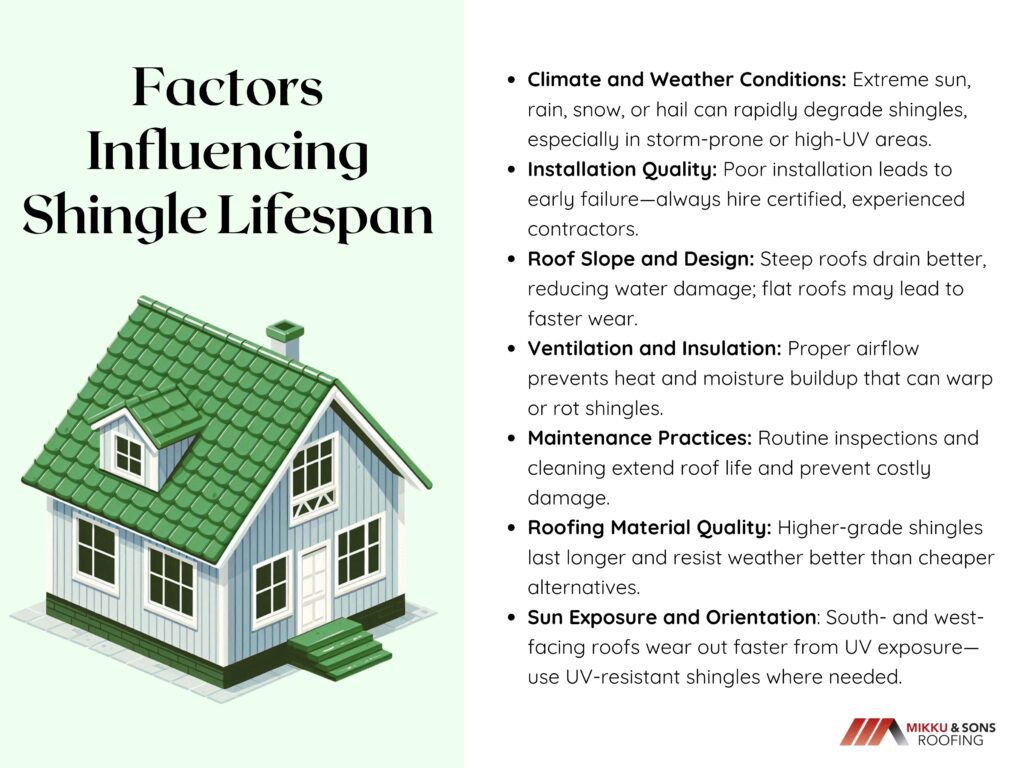
Extreme weather is one of the biggest threats to roof longevity. Constant exposure to intense sunlight, heavy rain, hail, snow, or freeze-thaw cycles can break down roofing materials over time. Shingles in regions with frequent storms or high UV exposure often wear out faster than those in milder climates.
Even the best shingles can fail early if they are not properly installed. Poor workmanship, such as incorrect nailing, lack of underlayment, or improper flashing, can cause leaks, lifting, and premature aging. Hiring a certified, experienced roofing contractor is crucial to ensuring your roof is installed to last.
The design and steepness of your roof can affect how well it sheds water and resists debris buildup. Steeper roofs tend to drain faster, reducing the likelihood of water damage and prolonging shingle life. Conversely, flat or low-slope roofs may experience pooling water, leading to faster deterioration.
Proper attic ventilation and insulation play a key role in regulating temperature and moisture beneath the roof. Poor ventilation can trap heat and moisture, causing shingles to warp, blister, or rot from the underside. A well-ventilated roof system reduces internal stress on shingles and supports a longer lifespan.
Regular maintenance helps catch minor problems before they become major issues. Removing debris, clearing gutters, inspecting for damage, and replacing broken shingles can significantly extend your roof’s life. Neglecting these simple tasks can lead to water infiltration, mold growth, and structural damage.
Not all shingles are created equal — some are made with higher-grade materials that offer better durability and resistance to elements. Investing in premium-quality shingles may cost more upfront, but can provide better protection and longevity. Manufacturer warranties often reflect the quality and expected lifespan of the product.
Roofs with greater sun exposure, especially those facing south or west, tend to age more quickly due to constant UV radiation. Over time, this can cause shingles to become brittle, fade in color, and lose granules. Using UV-resistant shingles can help mitigate this damage in sunny climates.
By understanding and managing these factors, homeowners can protect their investment, extend the life of their roof, and avoid costly repairs or early replacement. Regular inspections and smart roofing choices can make all the difference in maximizing your roof’s performance over the years.
Knowing when your roof shingles need replacing is crucial to preventing costly damage to your home’s structure. Here are some clear signs that your shingles may be nearing the end of their lifespan and need to be replaced.
Shingles that curl or buckle are signs of aging or poor ventilation. They allow water to seep in, increasing the risk of leaks and structural damage.
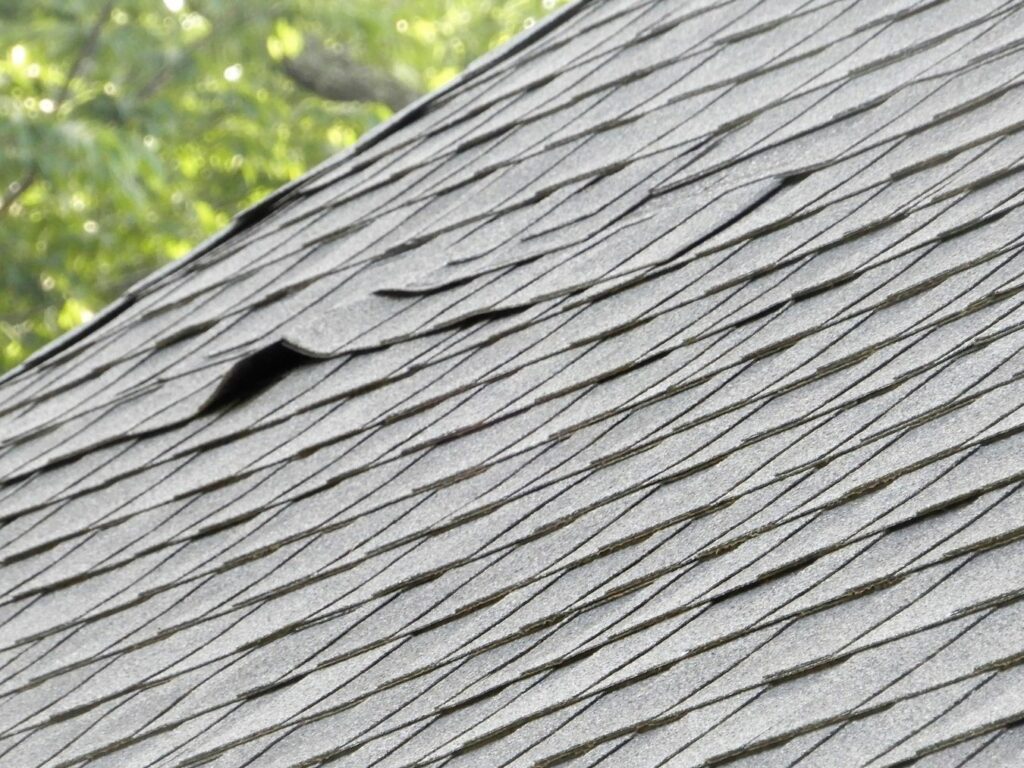
Cracked shingles often result from wind or aging and can no longer block moisture. Widespread cracking typically means it’s time for a roof replacement.
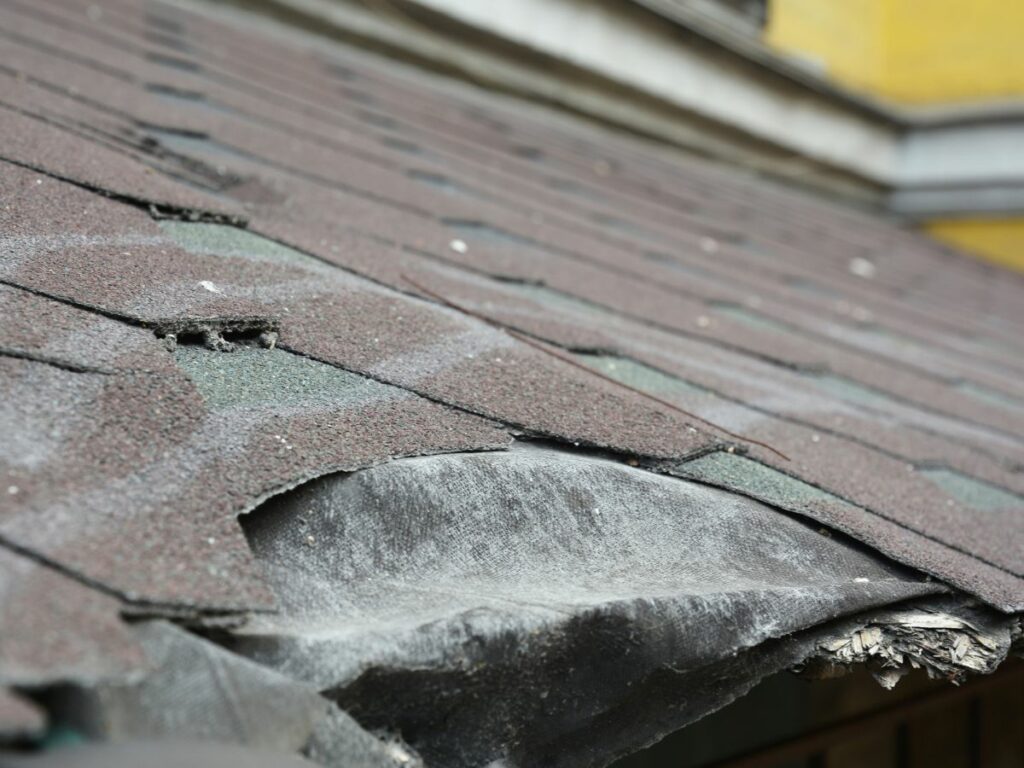
Missing shingles expose the roof to water damage and leaks. This is especially risky for older roofs with weakened bonding.
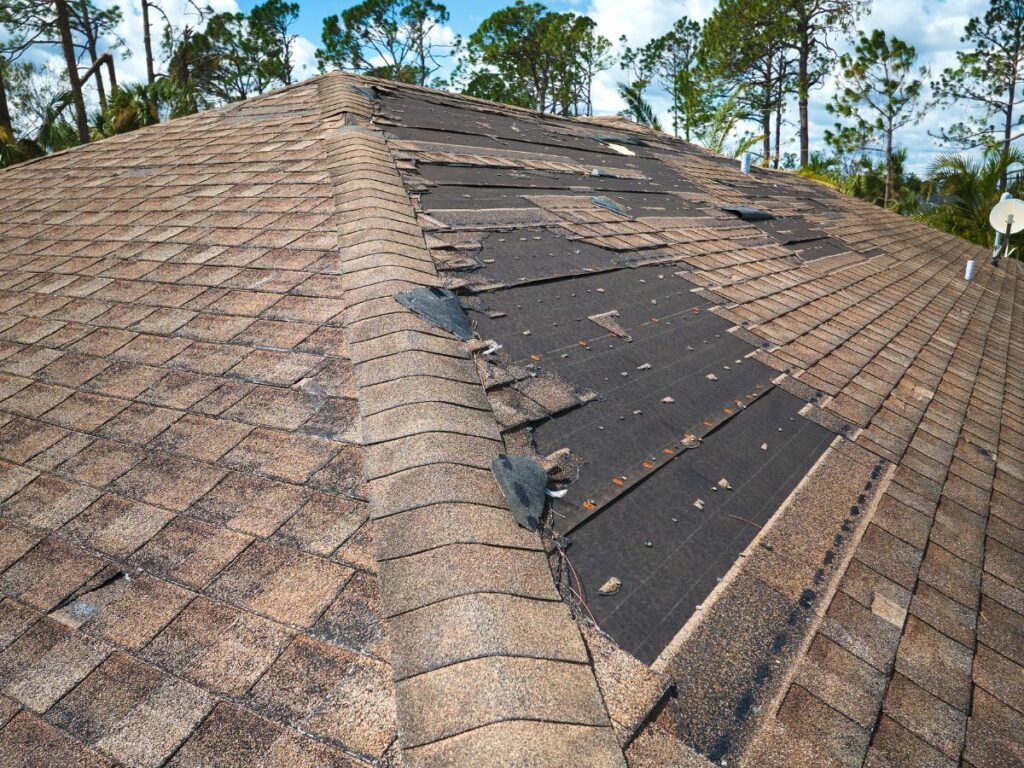
Granule loss leaves shingles vulnerable to sun and weather damage. Accumulated granules in gutters signal aging shingles nearing replacement.

Moss and algae trap moisture that can speed up shingle decay. Mold inside the attic may indicate leaks through worn shingles.
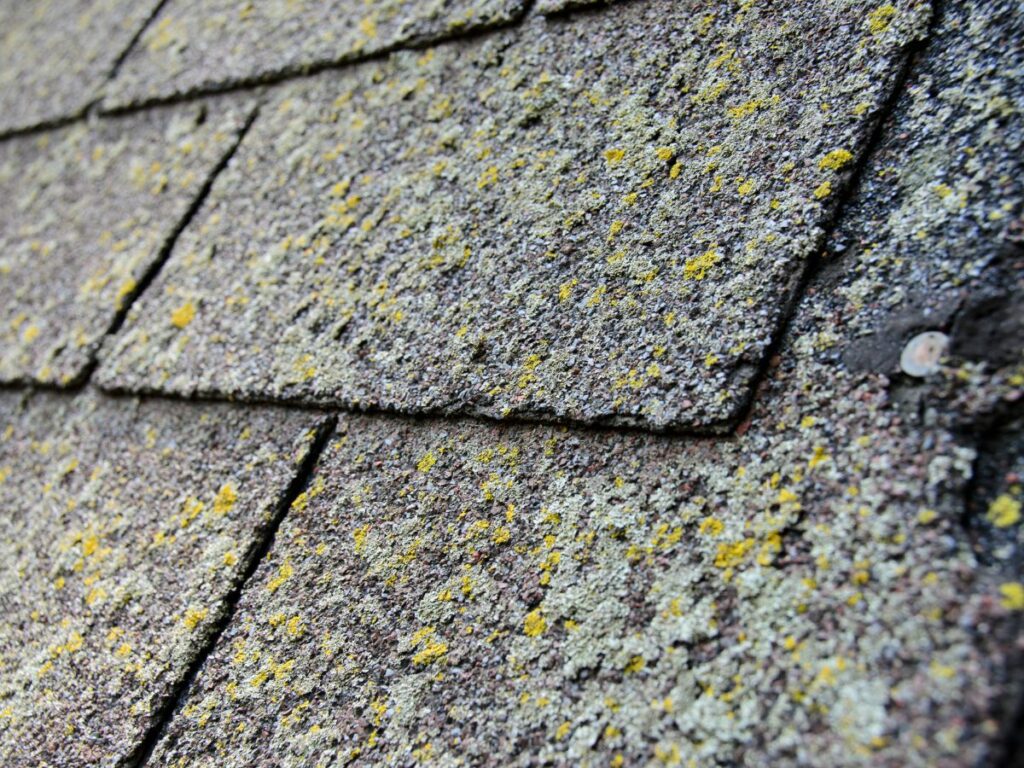
A sagging roof signals structural damage from long-term water issues. This usually requires urgent inspection and likely replacement.
Water stains on walls or ceilings suggest your roof is compromised. Even if damage isn’t visible outside, leaks mean the shingles are failing.

If you notice any of these signs, it may be time to consult a roofing contractor and consider replacing your shingles to maintain the safety and integrity of your home.
Extending the life of your roof is not only about choosing the right materials—it's also about how you care for and maintain your roofing system over time. Here are some effective tips to help you get the most out of your roof investment.
Having your roof professionally inspected at least once a year helps identify minor issues before they turn into major problems. Early detection of leaks, loose shingles, or wear allows for quick repairs that can prevent further damage. Inspections are especially important after severe storms or seasonal changes.
Clogged gutters can cause water to back up under shingles and lead to rot or ice dam formation in colder climates. By clearing out leaves, debris, and sediment regularly, you ensure proper water flow away from your roof and foundation. This simple task helps preserve the integrity of both your roof and your home's structure.
Leaves, twigs, and branches can trap moisture on your roof, leading to mold, algae growth, and deterioration of shingles. Regularly clearing off roof debris reduces the risk of damage and promotes proper drainage. It also prevents pests from nesting and causing further issues.
Branches that hang too close to your roof can scrape against shingles or fall during storms, causing physical damage. Trimming back nearby trees not only reduces wear but also limits the amount of organic debris that accumulates on your roof. It also improves sunlight exposure, which helps keep the roof dry and less prone to moss.
Good ventilation helps regulate attic temperatures and moisture levels, which is crucial for maintaining the underside of your roof. Without it, heat and humidity can build up, causing shingles to warp and insulation to lose effectiveness. Installing ridge vents or soffit vents can drastically improve airflow and prolong roof life.
Small issues like a missing shingle or minor leak can quickly escalate into expensive structural damage if ignored. Promptly addressing repairs helps maintain the roof’s protective barrier and prevents water infiltration. Being proactive with maintenance can extend your roof’s lifespan by years.
In areas with high humidity or frequent rain, algae growth can discolor shingles and degrade roofing materials. Choosing shingles with algae-resistant technology can help maintain your roof’s appearance and durability over time. This is a worthwhile upgrade for homeowners in moisture-prone regions.
By following these practical tips, you can ensure your roof remains in excellent condition for decades, protecting your home and saving you money in the long run. A little maintenance goes a long way when it comes to roofing longevity.
Roof shingles can last anywhere from 15 to over 100 years, depending on the material, installation quality, and maintenance. Common types like 3-tab asphalt shingles may last up to 25 years, while more durable options like metal, slate, or tile can last 50 years or longer. Recognizing signs of wear, such as curling, cracking, or granule loss, can help homeowners take timely action to prevent costly damage.
To ensure your roof reaches its full lifespan, regular inspections, prompt repairs, proper ventilation, and routine cleaning are key. With the right care and smart material choices, roof shingles can offer decades of reliable protection for your home.
When it comes to protecting your home, the choice of roofing material is crucial, especially in areas prone to wildfires or high temperatures. Fire-resistant roofing can significantly reduce the risk of fire spreading, providing an extra layer of security for your property and peace of mind for you.
Among the various roofing materials available, fiberglass shingles stand out for their excellent fire resistance properties. Fiberglass shingles are a popular choice for many homeowners due to their durability, aesthetic appeal, and affordability.
However, their fire resistance is a standout feature that makes them particularly valuable. Let's look at the fire resistance of fiberglass shingles.
Fiberglass shingles are a type of asphalt shingle that incorporates a fiberglass mat as the core of the shingle. This construction differs from traditional organic mat asphalt shingles, where the core is made of paper or wood fibers.
The fiberglass mat is coated with asphalt, and then ceramic granules are embedded on the surface to provide additional protection and aesthetic appeal. This design not only makes fiberglass shingles lightweight but also enhances their fire-resistant properties.
The popularity of fiberglass shingles has grown significantly due to their combination of durability, cost-effectiveness, and fire resistance. They are an ideal choice for homeowners looking for a reliable roofing material that can withstand various weather conditions while also providing a high level of protection against fire.
Fiberglass shingles are composed of several layers, each contributing to their overall performance.
The manufacturing process of fiberglass shingles ensures that they are less prone to warping and curling compared to traditional organic shingles. The fiberglass core is more stable and less susceptible to moisture absorption, which can be a common issue with other types of shingles.
When compared to other roofing materials, fiberglass shingles offer a unique blend of advantages.
Fire resistance ratings are a crucial factor to consider when selecting roofing materials, especially in areas susceptible to wildfires or where building codes enforce strict fire safety regulations. Fire resistance ratings classify materials based on their ability to withstand fire and prevent its spread.
These ratings are determined through rigorous testing procedures established by organizations such as Underwriters Laboratories (UL) and ASTM International. Understanding the fire resistance rating of fiberglass shingles can help homeowners make informed decisions about their roofing needs.
Class A fire resistance is the highest rating a roofing material can achieve. It indicates that the material can withstand severe fire exposure without igniting or contributing to the spread of flames. To attain a Class A rating, roofing materials must undergo a series of stringent tests, including burning brand tests, flame spread tests, and intermittent flame tests.
Fiberglass shingles often achieve a Class A fire resistance rating due to their composition. The fiberglass mat at the core is inherently non-combustible, and the asphalt coating, combined with ceramic granules, provides additional protection against fire.
This makes fiberglass shingles an excellent choice for homeowners looking to maximize their fire protection. A Class A rating not only enhances the safety of the home but can also lead to lower insurance premiums, as many insurance companies offer discounts for homes with high fire-resistant roofing materials.
While Class A is the highest fire resistance rating, Class B and Class C ratings also provide varying degrees of fire protection. Class B-rated materials can withstand moderate exposure to fire and are often used in areas with a lower risk of wildfires.
These materials must pass similar tests to Class A materials but are not required to perform as well under extreme conditions. Class C-rated materials offer basic fire protection and can withstand light exposure to fire.
They are typically used in regions with minimal fire risk or in temporary structures.
Fiberglass shingles offer numerous advantages in fire protection, making them a preferred choice for homeowners and builders looking for reliable and safe roofing materials. The combination of a non-combustible fiberglass core and protective asphalt coating, along with ceramic granules, provides a formidable defense against fire.

One of the most significant advantages of fiberglass shingles is their high fire resistance. Unlike organic mat shingles, which can easily ignite and contribute to the spread of fire, fiberglass shingles have a non-combustible core that does not burn.
This inherent fire resistance is further enhanced by the asphalt coating and ceramic granules that form a protective barrier against flames and heat. As a result, fiberglass shingles can achieve a Class A fire resistance rating, the highest possible rating for roofing materials.
This makes them an excellent choice for homes in areas prone to wildfires or regions with strict fire safety regulations.
Installing fiberglass shingles can significantly enhance the safety of a home by providing robust protection against fire. In the event of a fire, the fire-resistant properties of fiberglass shingles can prevent the roof from igniting and help contain the fire, giving occupants more time to evacuate and emergency services more time to respond.
This added layer of protection can be crucial in saving lives and minimizing property damage. Homeowners can also enjoy peace of mind knowing that their roof is made of a material specifically designed to withstand fire exposure.
Fiberglass shingles are not only fire-resistant but also highly durable and long-lasting. Their resistance to fire does not compromise their overall performance in other areas. Fiberglass shingles are known for their ability to withstand various environmental conditions, including strong winds, heavy rain, and extreme temperatures.
This durability translates to a longer lifespan for the roofing material, reducing the need for frequent replacements and maintenance. Additionally, the fire-resistant properties of fiberglass shingles remain effective throughout their lifespan, ensuring continuous protection for the home.
While the initial cost of fiberglass shingles may be comparable to other roofing materials, their long-term cost-effectiveness is a significant advantage. The durability and low maintenance requirements of fiberglass shingles mean that homeowners can save money on repairs and replacements over time.
Moreover, the high fire resistance of fiberglass shingles can lead to lower insurance premiums. Many insurance companies offer discounts for homes with fire-resistant roofing materials, recognizing the reduced risk of fire-related claims. This cost-saving benefit adds to the overall value of choosing fiberglass shingles.
Fiberglass shingles also offer environmental benefits, contributing to their appeal as a roofing material. They are often made from recycled materials, and their long lifespan reduces the frequency of replacements, leading to less waste.
Additionally, the energy-efficient properties of fiberglass shingles can help reduce heating and cooling costs, making homes more environmentally friendly. By choosing fiberglass shingles, homeowners can contribute to sustainability efforts while also enhancing the fire protection of their property.
When choosing roofing materials, fire resistance is a critical factor, especially in areas prone to wildfires or where building codes require fire-resistant construction. While fiberglass shingles offer excellent fire protection, it’s essential to compare them with other fire-resistant roofing materials to make an informed decision.
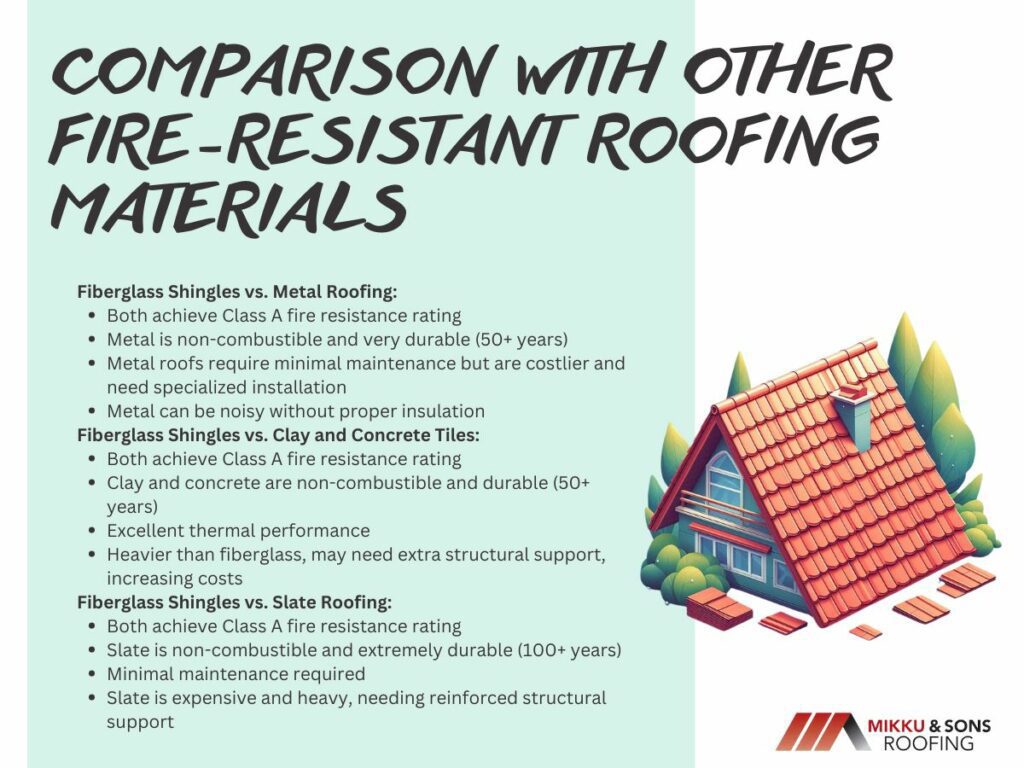
Metal roofing is another highly fire-resistant option, often achieving a Class A fire resistance rating similar to fiberglass shingles. Metal roofs are non-combustible, meaning they do not ignite or contribute to the spread of fire.
This makes them an excellent choice for fire-prone areas. Additionally, metal roofing is extremely durable, with a lifespan that can exceed 50 years, and it requires minimal maintenance.
However, metal roofing can be more expensive to install than fiberglass shingles, and the installation process is more complex, often requiring specialized labor. Metal roofs can also be noisy during rain or hailstorms unless proper insulation is used.
Clay and concrete tiles are renowned for their fire-resistant properties, often achieving Class A ratings. These materials are non-combustible and provide a robust barrier against fire.
They are also highly durable and can last up to 50 years or more with proper maintenance. Clay and concrete tiles offer excellent thermal performance, helping to keep homes cooler in hot climates.
The primary drawback of clay and concrete tiles is their weight. These materials are significantly heavier than fiberglass shingles, which can necessitate additional structural support and increase installation costs.
Slate roofing is another top-tier fire-resistant material, also achieving a Class A rating. Slate is a natural stone that is non-combustible and offers exceptional fire protection.
It is also one of the most durable roofing materials available, with a lifespan that can exceed 100 years. Slate roofing is highly resistant to weathering and requires minimal maintenance.
However, slate roofing is one of the most expensive options, both in terms of material costs and installation. The weight of slate tiles is also a significant consideration, often requiring reinforced structural support.
Fiberglass shingles offer an excellent combination of fire resistance, durability, and aesthetic appeal, making them a top choice for homeowners looking to enhance their home's safety. With a Class A fire rating, fiberglass shingles provide a high level of protection, reducing the risk of fire spread and potentially lowering insurance costs.
Choosing fire-resistant roofing materials is a critical step in safeguarding your home from the increasing threat of wildfires and other fire hazards. By choosing materials with high fire ratings you can significantly reduce the risk of fire spreading to your property.
By prioritizing fire safety in your home improvement projects, you are taking a proactive approach to protecting your family and property. As you consider your next roofing project, remember that choosing fire-resistant materials is not just about compliance with safety standards; it's about ensuring the safety of your home for years to come.
The construction sector is centered on sustainability, and as governments worldwide strive to achieve net zero emissions, the industry's involvement has gained increased attention. In today's world, whether it is related to raw materials or energy usage, it has almost become a buzzword.
Finding businesses that share this dedication is essential as more and more customers list it as a top priority. A reputable roofing firm has to be committed to sustainable roofing practices in order to uphold both their clients and their own commitment to better safeguarding the environment.
Though the roofing sector is currently among the biggest emitters of carbon dioxide, what exactly does sustainable construction entail? And how does your roofing solution and design contribute to reducing the industry's carbon footprint?"Sustainability in Modern Roofing" is not just a phrase but a guiding principle in the evolution of roofing practices.
Environmentally concerned people are rapidly adopting sustainability as a trend, and this trend can even apply to residential and commercial roofs. When anything is designed to meet or surpass environmental well-being requirements, it is generally referred to as sustainable.
Alternatively, running a company in this manner may be a more environmentally responsible strategy, which could improve the well-being of people. The goal of sustainability in building roofing is to significantly cut waste and create more energy-efficient roofing solutions that can lower energy consumption.
In building, sustainability can take many different shapes.
Reducing the industry's environmental footprint in order to mitigate climate change and ensure that there is a robust, sustainable building stock for future generations are the objectives of these campaigns.
Among the main objectives for modern homes is sustainability. This is evident in everything from modern HVAC systems to smart house systems and even in the particular materials used in roofing construction.
These environmentally friendly roofing materials are among the most well-liked styles for both new construction and roof replacements.

Although many homeowners believe traditional shingles are the best option, you might not instantly consider them sustainable roofing materials. Modern shingles, on the other hand, provide a variety of design features that contribute to your home's increased sustainability.
Cool shingles use a variety of contemporary methods, such as surface color, reflectivity, and granule size and type, to keep your roof cool. As a result, your roof absorbs less heat from the sun, which is very advantageous for the environment and your energy costs.
Many people have suggested that reflective surfaces, including roads and roofs, can be a useful tool in the fight against climate change. They could have a big effect if all those surfaces around the world were more reflective, like cool shingles.
In addition to keeping your roof cooler, cool shingles can also dramatically reduce summertime air conditioning costs. Both money and energy can be saved by reducing energy use.
Tile roofing is a classic design that is still widely used today. Installing a tile roof can typically be more expensive than putting shingles, but the roof should last longer.
Although there are many different types of tiles, clay is the most widely used. The fact that this material is all-natural gives it an advantage over a lot of other choices.
The tiles are capable of lasting a century or longer, making recycled tile roofing viable. You can repurpose used tiles for your roof rather than using up more resources and energy.
In most cases, salvaged and repurposed tiles are used when a tile roof is removed but still has an acceptable state of repair. You can simultaneously lessen your environmental effects and wear a true traditional style.
Low indoor air quality can be caused by the dangerous substances that traditional roofing materials can emit into the atmosphere. Sustainable roofing materials, on the other hand, provide a better atmosphere for building residents since they are composed of recyclable and non-toxic components.
One or more layers of different plastic, rubber, or composite materials are the foundation of membrane roofing systems. Although they're already frequently used in commercial settings, they might be a great choice for your house as well.
The different layers act as insulation, heat-dispersers, and water-repellent materials. With the help of current initiatives and programs for recycling asphalt, we are finally beginning to use old asphalt shingles that are being recycled in some states, such as paving roadways. There are plenty of options, so you might find the ideal fix for your next roof.
When asphalt roofing reached the end of its useful life, it was all disposed of in landfills. With the help of current initiatives and programs for recycling asphalt, we are finally beginning to use old asphalt shingles that are being recycled in some states like paving roadways.
The U.S. creates millions of tons of asphalt shingle garbage every year. Shingle recycling is becoming more popular and contributes to reducing garbage in US landfills.
Some people give their old shingles to nonprofits so they can be used for good. Before you replace your roof, find out if your roofing contractor recycles its shingles. It's a simple way you can do your part for the environment.
Since they became more accessible to the typical home and business owner, solar panels have exploded in the residential market. Switching to more environmentally friendly power sources is another method to lessen your carbon footprint, with solar panels being one of the most popular choices.
It is necessary to have a roof that can support the weight of the panels, though. Solar-ready roofing systems are getting more and more popular, which is not surprising given these advantages and tax incentives.
The country is seeing a surge in the popularity of metal roofing as an alluring and sustainable replacement for conventional asphalt roofs. Because metal roofs reflect solar radiation rather than absorbing it, they are significantly more energy-efficient than asphalt roofs.
While it might be very challenging to recycle or reuse some roofing components, the majority of metal roofs are comprised of more than 56% recycled elements, making them sustainable. The longevity of the building itself is extended, and metal roofs outlast other kinds, both of which increase the overall sustainability of this roofing style.
Energy-efficient skylight use is another trend that is becoming more and more popular in the field of contemporary roofing. You consume less energy during the day because you don't need as much artificial lighting because these skylights let in natural light.
Additionally, insulating elements on modern windows frequently prevent heat absorption in the summer and loss in the winter.
Since heat rises within a home, an attic with inadequate ventilation can become significantly hotter. This may result in your HVAC system using more energy to cool your house and costing you more.
Modern roofers create unique ventilation designs for each home to optimize airflow into and out of the structure. In addition to safeguarding your roofing system, a well-ventilated attic may stop problems like ice dams, mold growth, and shingle damage.
Insulation has a major role in your home's overall energy consumption and is essential in the effort to build energy-efficient homes. Your utility cost can be significantly reduced by replacing your outdated roof and installing new insulation, which can also have a significant impact on your household's overall energy consumption and carbon footprint.
Though there are many opinions on this broad subject, one thing is certain: the insulation industry is dynamic and innovative, with rising thermal efficiency and fire safety serving as key catalysts. Increased insulation helps keep buildings warmer in the winter and colder in the summer. It also plays a major role in reducing cold structures, which helps regulate interstitial condensation.
Making the switch to sustainable roofing has several benefits. In addition to being better for Mother Earth and what many refer to as a "greener" alternative, it can also result in a variety of other advantageous outcomes, such as:

There has never been a better moment for people to lessen their negative environmental effects than right now. Thankfully, homeowners may take a number of steps to make sure their property contributes to the solution rather than the issue.
Roofing tax credits and incentives are offered by some states for specific roofing projects since the roofing industry is always evolving to satisfy the demand for environmentally friendly solutions. The industry is constantly expanding, offering everything from solar and cool roofing to green roofing solutions and sustainable materials.
As long as sustainability is given first priority, roofing solutions in the future should be even more creative and advantageous to the environment. When it's time to fix or replace your roof, take these trends into account and choose a solution that will save costs and the environment.
One of the most important things about your Arizona house is the roofing material choice. Along with providing weather protection for you and your possessions, it also significantly improves the overall look and energy efficiency of your house.
In Arizona, extreme weather events such as windstorms, snowfall, fires, or even minor things like ceiling leaks can necessitate new roofs. Arizona has harsh weather all year round, with scorching summers, slightly tolerable winters, surges of rain, occasional hurricanes, etc. Choosing the right roofing material for Arizona homes is essential.
The regular variations in weather can have an impact on your roof's condition. Choosing the correct roofing material for Arizona is crucial because of its hot summers and moderate winters.
The answer genuinely relies on what matters most to each homeowner, be it longevity, simplicity of care, overall installation costs, or aesthetics. In summary, each type of roofing system has benefits, drawbacks, and environmentally friendly aspects.
A number of elements, including the overall design, the quality of the materials, the surrounding environment, and the caliber of the installation, will affect how long your roof lasts. When properly maintained and installed by a trained roofing specialist, today's top roofing products can easily last for decades.
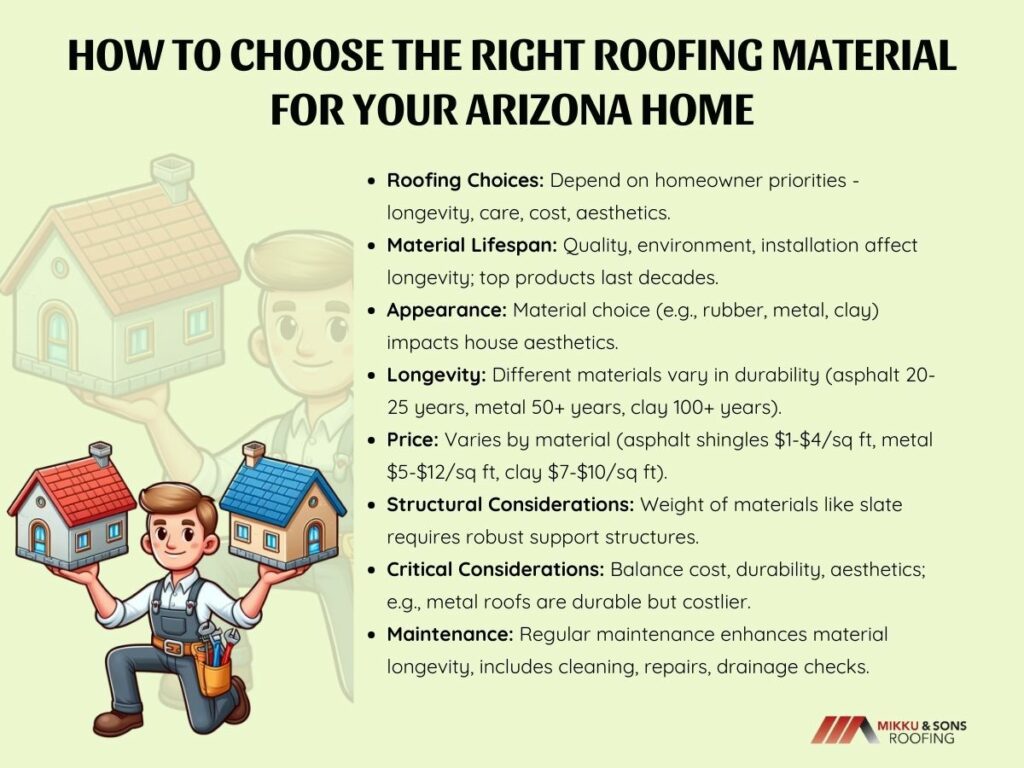
Achieving an appealing look for your roof is a vital part of home design. The visual impression of the roofing materials you choose can enhance or degrade the overall aesthetic appeal of your house.
The appearance of various roofing materials, such as neoprene, EPDM, PVC, chlorinated polyethylene, chlorosulfonated polyethylene sheets, polymer-modified bitumens, and green roof options vary in texture, color shade, style shape, and other features like sheen and translucency. A flat roof appears sleek with rubber roofing membranes or thermoplastic olefin (TPO), whereas metal roofing gives a rustic charm to residential properties.
To achieve optimum results for your home frontage styling while considering other factors such as durability and cost-effectiveness when selecting the appropriate type of roofing material.
The lifespan of a roofing material depends on several factors, such as the quality of the material, proper maintenance, and the environment in which it is installed. Choosing a durable and long-lasting roof can save you money in the long run by reducing repair costs and replacements.
Different types of roofing materials have varying levels of longevity. For instance,
Moreover, other types of roofing materials like wood shingles and shakes or slate tiles may have an extended lifespan but are vulnerable to damage from harsh weather elements such as snow storms or hail storms. In areas where heavy rainfall is common, some roofers recommend rubber tiles because they tend to age well in wet conditions.
The pricing of different types of roof materials is an essential factor in determining the most suitable option for residential roofing. Here are some insights into material price trends for modern roofing materials:
While asphalt shingles provide a relatively affordable option, metal roofing, clay tiles, and concrete tiles tend to cost more. Despite varying prices, it is crucial to make decisions based on the material's durability, energy efficiency, and overall lifespan.
Ensuring that the roof can handle the weight and stress of certain materials is crucial in avoiding potential damage or collapse. Some roofing options, such as slate or ceramic tiles, are heavier than others and require a more robust structure to support them.
On the other hand, lighter options like asphalt shingles may not need as much support but may have a shorter lifespan. It's, therefore, important to consult with experts who can evaluate your home's condition and recommend appropriate roofing material options.
Understanding the critical considerations for a roofing project involves evaluating factors that impact both roof replacement costs and specific needs. For instance, metal roofing, though initially more expensive, proves economical over time due to its durability, reducing the need for frequent replacements, as seen with materials like asphalt.
Furthermore, the aesthetic appeal of clay tiles must be weighed against their weight, brittleness, and delicate nature during installation. In contrast, metal roofs offer durability without compromising on looks.
Cost-effectiveness can be maximized across various roofing materials through diligent maintenance. Simple routines, such as regular cleaning and timely repairs, can prevent further damage to the roofing system, ultimately reducing overall costs.
For instance, performing drainage checks and clearing debris from gutters helps mitigate soil erosion that can harm roofs over time. Investing in proper maintenance practices is a proactive strategy to enhance the longevity of your chosen roofing material.
In Arizona, roofs have to be able to endure intense heat, scorching sun rays, wind, and rain during the monsoon season. A roof may be damaged over the years by extremely hot weather, and as Arizona's climate can fluctuate greatly from hot to cold to hot again, the materials used must be robust, long-lasting, and heat resistant.
Remember that during windy and rainy seasons, inadequate roofing might result in significant water damage. Which roofing types and materials are, therefore, ideal for homes in Arizona?
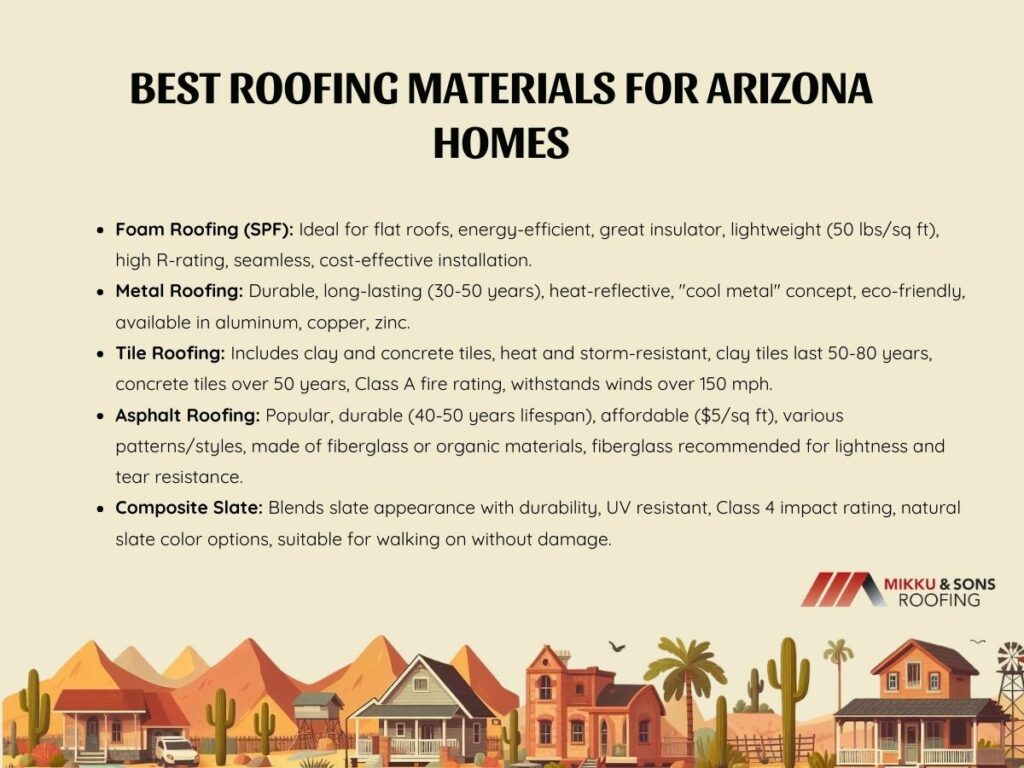
For flat roofs in Arizona, especially prevalent in commercial properties, Spray Polyurethane Foam (SPF) roofing stands out as the optimal choice. Renowned for its energy efficiency, this roofing type is particularly favored by commercial property owners seeking effective insulation and long-term savings.
The efficiency of SPF roofing is further underscored by its high R-rating of approximately 6.5 per inch, reflecting its exceptional ability to deflect heat and maintain cooler indoor temperatures during the scorching summer months. I
Contrary to preconceptions, metal roofs, available in shingles or panels, can seamlessly integrate into any neighborhood with a modern and sleek appearance. The inherent strength and durability of metal make it a long-lasting option, requiring replacement only after decades of reliable service.
One of the standout features of metal roofing is its ability to redirect heat, contributing to a cooler interior. This enhances comfort and aligns with the concept of "cool metal roofing," potentially reducing long-term energy costs.
Reflecting heat efficiently, metal roofs demonstrate eco-friendly characteristics, providing a dual benefit of sustainability and financial savings. Standing seam metal roofing is a popular option with a functional lifespan of between 30 and 50 years.
It is characterized by steel panels with overlapping seams that form raised ridges along the roof slope. Aluminum is a great material for this style since it is both lightweight and robust. Copper and zinc are other good choices; copper acquires a distinct look as it weathers.
In the arid landscape of Arizona, roofing choices play a critical role in enduring the harsh conditions, with two prominent contenders being concrete and clay tiles. Recognized for their classic charm, clay tiles are a common sight in Arizona homes.
Concrete tiles, another prevalent option, offer a cost-effective alternative with enduring strength. Crafted from a mixture of sand, water, cement, and iron oxide, these tiles undergo molding and heating, resulting in a robust, natural-looking roofing material.
While both concrete and clay tiles share longevity and resistance to the elements, each presents unique characteristics. Clay tiles boast an unmistakable aesthetic appeal, while concrete tiles offer a pragmatic and economical solution.
Choosing between these two materials involves thoughtful consideration of both visual preferences and specific durability requirements, ensuring that your Arizona home stands resilient against the test of time and nature.
Asphalt shingles are a common option, found in 80% of American homes, due to their durability and incredibly low cost ($5 per square foot). The lifespan of asphalt shingles can range from 40 to 50 years, depending on the quality used. However, re-installation is not a big deal because they are reasonably priced.
The fact that shingle roofs are available in a variety of patterns and styles contributes to their appeal. Additionally, there won't be as many options available to you, which makes this roofing quite inviting.
Either organic material or fiberglass is used to make the asphalt shingles. It is advised to choose fiberglass shingles due to their lightweight, ease of installation, and resistance to tearing and damage. Organic shingles, on the other hand, are heavier but provide more stability.
Composite slate emerges as a versatile choice, seamlessly blending the allure of quarried slate with practical advantages. This roofing option marries natural aesthetics with lightweight, durable construction, eliminating the need for costly substructure modifications.
One of the standout features of synthetic slate roofing is its enhanced resistance to the relentless Arizona sun, thanks to the inclusion of UV inhibitors. Moreover, these tiles exhibit a substantial weight-bearing capacity, allowing homeowners to walk on the roof without risking damage.
With a prevalent Class 4 impact rating, composite slate ensures durability against external forces, providing homeowners with peace of mind. Notably, the composite slate market offers a broad spectrum of natural slate colors, allowing for a customized and visually appealing roofing solution.
This innovative material combines the charm of authentic slate with modern engineering, offering an ideal compromise between aesthetics and practicality for Arizona homeowners seeking enduring roofing solutions.
Now that you are more knowledgeable about the best roofing materials in Arizona consult with a roofing expert to help you make an informed choice and get the most out of your new roof in the long run. However, the journey towards a well-protected home doesn't end there.
Armed with the knowledge of choosing the right roofing material, it's equally vital to implement effective ventilation systems. Adequate ventilation not only safeguards your investment by preventing heat-related damages but also enhances energy efficiency within your home.
Transitioning from the importance of roofing materials, it's imperative to recognize the symbiotic relationship between your roof and proper ventilation, as discussed in "The Importance of Proper Roof Ventilation in the Arizona Heat."
Roof shingles are flat rectangular elements laid from the bottom up, and they successively overlap to work as a roof for a structure. They come in different types and colors, and ceramic shingles are popularly known as tiles.
The most common type is asphalt shingles, and they are easy to install, relatively affordable, and durable.
Roofing your house is a big task; without the right steps, you may end up with a damaged roof over time. This guide brings light to this task-full activity, so continue reading below, where we delve into How to Shingle a Roof.
If you're unsure whether you should shingle your roof, look at our article, where we weigh out the pros and cons. Or if you're an outdoor person and want to sit outside despite the weather, you should consider adding a porch roof.
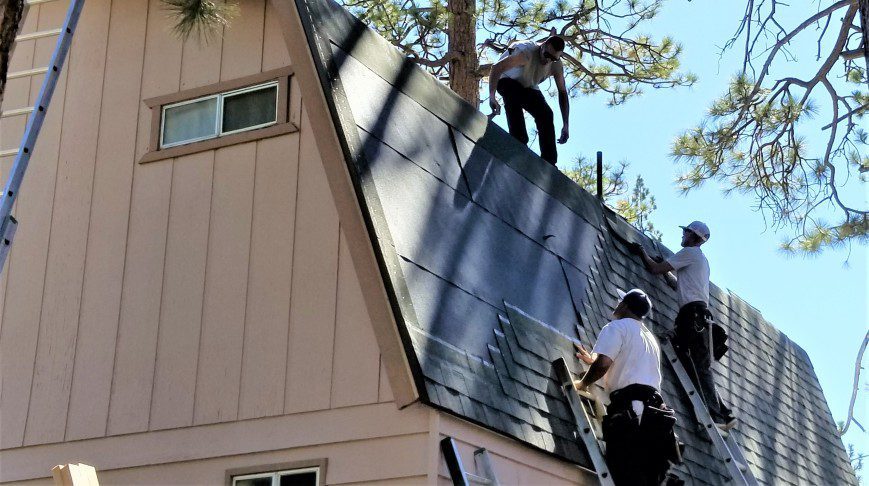
Before you decide to take on the project yourself, you need to determine whether you'll be able to perform the task without professional help.
Many concerns come with roofing a house, including the fear of heights. If you can walk on your home's roof comfortably, you can complete the DIY roofing task.
You'll need to have the energy to do all the manual jobs, such as carrying the shingles up a ladder to your roof and installing them.
To shingle a roof, a few terms you will have to have at your fingertips are described throughout this article.
This is installing metal material on a roof to direct water away. It may have to be replaced if rusted or worn out (curled up or torn).
This is metal flashing interwoven with the adjacent shingles. They are nailed and held in place along the adjacent shingles and sealed with roofing cement to prevent water from seeping through.
The valleys are where two roof parts with different pitches or angles meet. This place is vulnerable to water penetration and is protected through valley flashing.
They may be installed along with the roof underlayment or deck before the shingles are installed. They should last as long as the shingles because replacing them involves removing them.
This is flashing around the vent piping. It is sealed with roofing cement to prevent run-off water from seeping through.
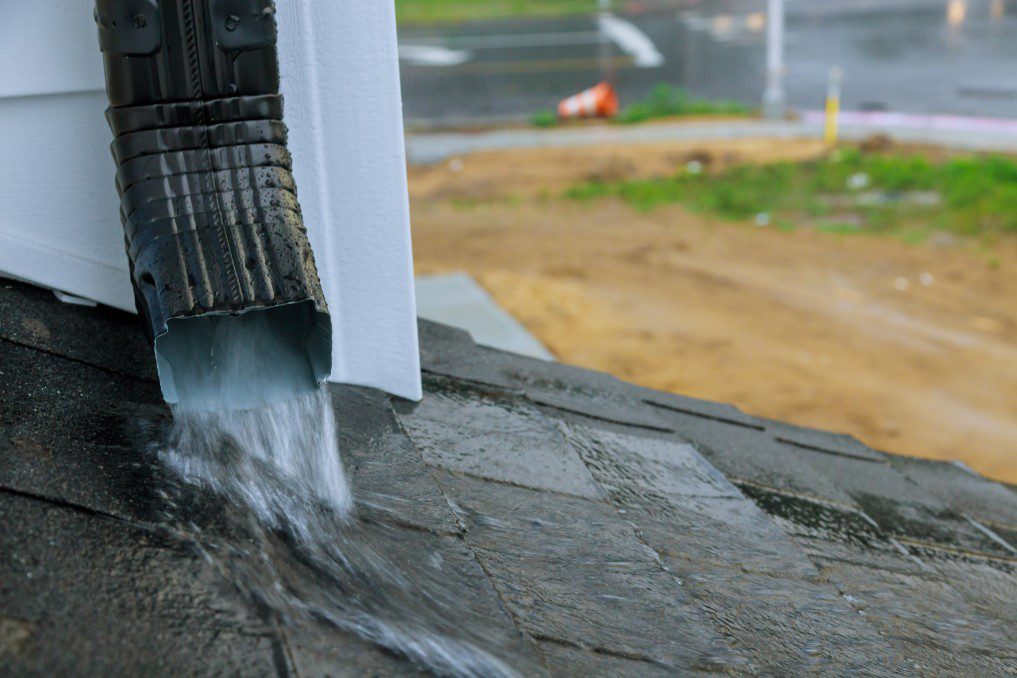
This is ice and water dam protection that prevents damming on a roof. This could cause the roof to collapse due to increased point load on the roof frame.
The roof deck is the material placed on the rafters and onto which the roof cladding will be installed.
This is a secondary protective layer installed on the roof deck. It protects the roof from water that may seep through the nail holes of the shingles.
There are synthetic and felt underlayments, and they each have advantages and disadvantages. The type of underlayment you use depends on the location, type of roofing material, and budget, among other factors.
Synthetic underlayment is more durable and offers better protection than felt underlayment. It is tough, easy to install, safe, and water repellent.
Some are slip-resistant and offer a workable surface once installed. They are also not damaged by prolonged UV or moisture exposure when it takes a while to add the shingles.
When thinking about how to shingle a roof, I can tell you many nails are involved! The prospect of hand-nailing more than 2000 nails is extreme, and that's where an air gun can come in handy. However, both methods have advantages and disadvantages.
The main difference between the two methods is the accuracy and precision of hand nailing. The placement of nails is important because of the limited area they go on a shingle.
The head of the nail stops flush with the top of the shingles, and it is necessary to maintain the nail line.
Under-driven nails also make for an uneven shingled roof and make the shingle susceptible to wind damage. The wind may also pop the shingle off the nail, causing a leak.
The air compressor for the nail gun has to be at good pressure to drive the nails in correctly. Hand nailing offers more precision but requires more time and energy.
To shingle a roof safely, you must adhere to a few precautions.
Safety is the most important concern when installing a roof. Falling is one of the most common causes of injury, and you must pay attention to safety.
| While Using a Ladder |
| ✅ Make sure it is properly installed. It should be tall enough to reach the roof and strong enough to support a significant weight in the middle without collapsing. |
| ✅ Position it well at the top and the bottom of the roof. If possible, tie it in place to prevent it from slipping or falling. |
| ❌ Don't use the ladder when your arms are full. You can use a bucket or anything suitable to get things onto the roof. |
| When Working on the Roof |
| ✅Walk with care because you never know which part of the roof may have been weakened over time. |
| ❌ Don't walk backward as the expectation you're used to is to step on a flat and not tilted surface. This may cause you to lose your balance and fall off the roof. |
Before you begin learning how to shingle a roof, you must remove all previous old shingles.
Next, you'll want to check that your deck is securely fastened to the roof truss, free of any holes or gaps, and completely dry and smooth. This will give you a flat, seamless shingle roof in the end. Your decking is crucial as it's responsible for holding the shingle, so it has to be prepped to handle the weight.
Once you have ensured you are completely safe while installing your roof, you can continue reading on to our step-by-step guide on How to Shingle a Roof!
Asphalt Shingles: 2 days

The underlayment is the most crucial part of discovering how to shingle a roof.
Your underlayment layer sits between the shingles and the roof deck and helps to offer secondary protection from the elements.
The underlayment comes in rolls and is installed overlapping toward the top of the roof.
If you have installed an eave or ice dam protection, overlap it at the edge by 4". A roof has open and closed valleys. However, it is necessary to overlap the underlayment by about 6" at the valley membrane flashing for protection from water that may go down the valley.
If you don't have eaves or ice and water protection, install the underlayment hanging between ¼"- ¾" from the edge.
Generally, ice and water protection is used on roofs in northern states. For example, roofing companies in Kalispell would install ice and water shield.
Install the second layer upwards, overlapping by about 2". When you reach the ridge of the roof, roll out some excess underlayment to each side of the roof to provide a better seal.
Two types of valleys are open and closed, which are prone to water penetration. Closed valleys are covered up when installing shingles.
Flashing an open valley is recommended to provide a waterway down the roof. Flashing is done by installing a metal valley, preferably 28-gauge metal, to withstand the elements.
When installing the flashing, caulk the edges to provide a watertight seal.
For areas like chimneys and roof vents, install flashing around the area and caulk the edges to provide a watertight seal.
Asphalt shingles are relatively easy to cut to size. Once the underlayment is laid out, installing the shingles is the next step toward completing your roof.
You can either get prepping material for starter shingles or fashion them from the shingles you already have. They provide a sealed adhesion point and water-shedding protection at the adjacent shingle joints.
The lower part of the roof is the most sensitive and can damage by wind or water. The starter shingles are installed below the first row of shingles and along the rake, edges to get you started on the shingle installation.
Use a chalk line to mark out the lines that will guide you in installing the shingles. This is good for aesthetic purposes because you don't want an uneven row of shingles.
This also helps determine the number of shingles you may need for your roof. Remove the tabs from the shingles to get them ready for installation.
Place the first shingle over the chalk line and secure it with a nail gun. Subsequently, install the rest of the pieces horizontally till the first row is covered.
Install the rest of the rows, overlapping the shingles as per the required length of the shingle manufacturer. Extend the shingle installation past the ridge to provide a watertight seal when you get to the ridge.
If you choose to have a closed valley installation, extend the shingles at least 12" past the valley centerline and add extra fastening to the end.
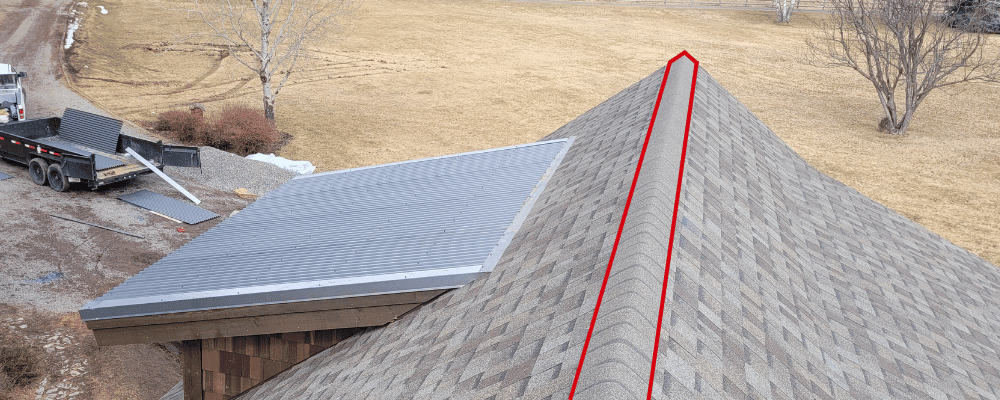
The final step of learning how to shingle a roof is to cover up the roof's ridge. If you choose not to overlap the shingles at the ridge, you can also place caps horizontally along the ridge to provide protection.
They are typically installed from one side to another, and the hips are installed vertically. Install them with the first ridge cap facing the opposite direction of the prevailing wind.
You will need longer nails when installing ridge caps, as they have to penetrate both the caps and the last shingles. To provide a watertight seal, you may seal the exposed nails with roofing cement.
The hip caps are installed from the bottom up to the ridge and are sloped ridges. Install the caps from both ends and connect them to a hip roof at the middle meeting point.
Supply:
Tools:
Materials: Roof flashing Underlayment Shingles Roofing cement
Asphalt roof shingles are made out of long-chain hydrocarbons. With time, the loss of oil makes the shingle fibers shrink.
This exposes the nail heads used to hold them in place during installation. Once exposed, water can seep into the house and cause damage.
If you can see the nail heads on your shingled roof, it's probably time to re-shingle it.
Using a shingle shovel, you can easily remove any existing shingles with one quick gesture.
The shovel has teeth that grab the shingle, and when the handle is pushed, it raises the other end. This is easier than prying the nails with a hammer and speeding up the process.
How you nail shingles on a roof determines the roof's overall look and durability. Nailing the shingles incorrectly could cause:
1. Raised shingles
2. Blown shingles
3. Curled shingle edges
4. Leaking roofs
The shingle nail pattern for most shingle companies should be no further than 1" from the shingle edges. A 4-nail pattern is commonly used, but in some roof types, like steep slope roofs, this may go up to 6.
To fix nailing mistakes:
1. Drive in under-driven nails with a hammer.
2. Remove crooked nails with a hammer and fill the holes with roofing cement.
3. Fix a new nail or install a new shingle.
Remember that shingles are installed in an overlapping pattern, and messing up an installation may be a severe problem.
It is metallic and is installed along the fascia boards to prevent water from running down them directly and prevent the shingles from curling over the edge.
A roofing system is a big investment for property owners, and represents a big portion of construction costs.
It’s a roofing contractor’s job to help the owner protect their investment. They should provide professional, careful maintenance on the roof on a regularly. This will make sure its properly protected.
Here are some tips that will help your roofing contractor ensure they won’t miss any essentials during services. If you’re a homeowner, these tips will guide you on what to expect when you hire a professional roofing company to perform routine shingle roof maintenance.
A roofer should perform 4 basic services twice per year to help a homeowner properly maintain their asphalt shingled roof. Also, you’ll want to do this after major storms. Here’s your roofing maintenance checklist:
A critical part of roof maintenance is routine cleaning and clearing of the roof and its related systems. Pay attention not only to shingles and flashing but other key elements, like eaves, troughs, down spouts, installations (such as skylights, vents, chimneys, solar panels), and ventilation.
Here’s what we recommend:
Property owners should regularly clear debris from the roof, including leaves, branches, and other items that might clutter the surface. Your roofing contractor might use a leaf blower, being sure to blow the air down the roof. This will ensure that debris won’t be blowing up and underneath the shingles. To lower the debris that accumulates, clear away vegetation and branches that hang over the roof. Hire a professional tree service to cut away difficult or hard to reach areas.
Dig out leaves and organic material from all gutters. This will ensure water drains without obstruction through to the downspouts. Homeowners could install eave protectors, metal meshed grates that prevent buildup of debris and make cleanup easier.
Be sure the downspouts are clear and unobstructed so water drains properly from the roof and away from the foundation. A homeowner should take notes of any leaks or drips that occur during or right after a rain storm. Report any issues to the contractor during inspection time.
Once cleared of debris, your roofing contractor should inspect it for any red flags that could indicate potential trouble.
They should complete this inspection twice a year – recommended in the spring and fall. This will allow them to make note of anything suspicious, as well as complete small fixes or minor repairs before they become bigger issues. Also, they’ll see if there’s any evidence the ventilation system is malfunctioning or might need maintenance or cleaning.
An experienced roofer should immediately complete any asphalt shingle roof repairs to maintain the integrity of the roof’s materials and related systems, such as drainage and ventilation. Little fixes performed properly will prevent bigger issues, or more costly repairs, over time. They could:
Replace or repair missing, broken or buckled shingles: A roofing contractor could use roofing cement or nails to repair shingles that have become cracked or loose. They could also replace any shingles that have broken free or blown away.
Replace or install valley flashing: They may also consider replacing the existing valley flashing if its become corroded, cracked or is no longer secure – which would threaten its waterproofing abilities.
Replace other flashing: Your roofer could use roofing cement and nails to replace metal flashing around chimneys, roof vents or other installations if the flashing has become loose or rotten. If they’re installing the flashing against a brick structure, it’s advisable to use copper or galvanized steel, because the lime in brick mortar could corrode aluminum materials.
Repair gutters or downspouts: Your roofing company might use gutter caulking, a gutter patching kit or roofing cement and patches to fix leaky or corroded sections of the eavestroughs or downspouts. If they are sagging, they should use a level to determine the proper pitch, then rehang them so they drain properly.
Whether you’re a homeowner looking to maintain the life of your roofing system, or a roofing professional educating your customer on the benefits of regular inspection, maintenance and repair, sticking to a consistent, regular schedule is well worth the investment.
Your roof plays a huge role in protecting your property and everything inside that you own. Anytime the roof’s structure is in trouble, you need to take action right away to fix the issue.
If you don’t fix a damaged roof, it can lead to big problems and expensive repairs down the road. This article will discuss the things you should consider before installing a shingle roof.
Some people like to keep the costs down by doing part or all of the job themselves.
Most of the time, it’s safer to hire professional, experienced roofing contractors because they have valuable knowledge and experience as well as training in the appropriate materials to use, proper installation, safety procedures, building code requirements, and waste disposal.
Here are some tips for hiring the right contractor:
Most cities and local governments will require permits for roofing work. Most roofing contractors will do the basic work for obtaining these permits, but you should know what the costs and time frames for permits are beforehand.
This way you can add these expenses to your budget and the additional time to the project’s schedule — the sooner you know these time frames and costs, the better.
Some roofing contractors might propose you leave your old roof in place and consider installing a shingle roof on top of it. It will save money but you should avoid this.
When an old roof is removed, the roofing contractor can inspect the decking and other areas for any possible structural damage that may exist. You could be creating a more costly repair by adding a new roof without removing the old one.
There are a lot of roofing materials to pick from, like wooden shakes, clay, metal, and slate.
Asphalt shingles are a happy medium for many property owners because they come in lots of shapes and colors, they’re the most affordable, the easiest to install, and usually last for 15-20 years.
Schedule your roof repair or replacement during a time when weather in your area is most favorable. Most roofing projects will be completed in a week to a few days if the weather is permitting.
Some roofers give discounts if you schedule the project during their slow season, so make plans ahead of time with your scheduling and you could save yourself a lot of money.
If you’re a property owner, you can’t predict when and how severe weather will hit you. You’ll need to take steps when your roof is damaged and you’ll need to completely understand the steps to take. Severe rain, high windstorms and monsoons can all cause heavy damage to your roof.
After your roof experiences severe wether, you have to assess the damage you’ve experienced. You can then be able to discuss what happened with your insurance representative and your roof repair contractor to help you avoid hidden costs or issues. (You should do this during daylight hours, which means you might have to skip to step 2 before you inspect the damage.) Use binoculars when you’re checking the damage so you can see the details closely.
Take the area thats been damaged and figure the estimated square footage. Look to see if there are any shingles missing and note how severe the damage is. In some smaller cases, you may just have a few random shingles missing or sheered off. Make a note of the material that’s visible and exposed. Here’s what to look for – the ends of missing shingles, tar paper or exposed plywood. Notice the shade and color of the material thats exposed. If you have some shingles from when the roof was installed or last repaired, you can check the packaging for the right shingle style and color you’ll need.
If you have a little experience with repairs, try to make some temporary fixes to minimize your damage. Personal items inside your home could be damaged by water if your roof is leaking directly above a living area. Put a garbage can or bucket under any leaking water and move any valuable items away from the area so they won’t get damaged more. You may need to use a tarp to cover badly damaged areas to get them waterproofed immediately. If they’re smaller repairs that are needed you can get them shingled right away.
Call your insurance representative and check your insurance policy if it looks like there’s enough damage for a claim. If there isn’t, it may make more sense money wise to hire a roofer yourself and get any needed repairs done. If you’re involved in a large, natural disaster where big swaths of residential properties are hit by severe weather or a big storm, you may want to contact your insurance company ASAP so you can get on a good contractor’s schedule immediately. Good, reputable roofing companies will have their calendars filled up quickly after a severe storm in their area, due to demand.
If you need to hire a roofing contractor, be sure it’s a reliable, professional roofing company. Be careful not to hire any fly-by-nighters that flood these areas after a storm and rip off vulnerable, uneducated property owners. Avoid these type of contractors at all costs. These traveling contractors that chase storms around will give you poor quality workmanship and be gone as fast as they arrived, leaving you with bigger issues than you had from just the storm.
The flexibility of shingle roofing is demonstrated here in our diverse Arizona weather. Most cities in Arizona have warm and dry weather. In the major metro areas of Phoenix and Tucson, summer months bring hot, sweltering days and winter brings crisp cool air. Other areas in North Central and Northern Arizona have a mountainous climate where the summers are mild and sunny and winters have snow and cold winds. In this article, we will be discussing the pros and cons of shingle roofs.